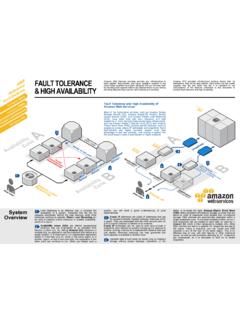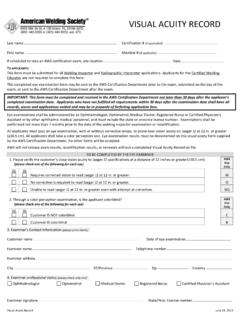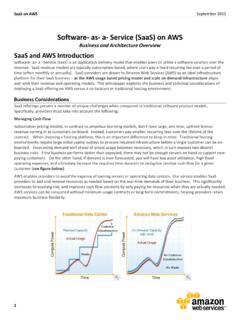Transcription of Development and Test on Amazon Web Services
1 Amazon Web Services Development and Test on Amazon Web Services November 2012 Page 1 of 17 Development and Test on Amazon Web Services November 2012 Carlos Conde, Attila Narin (Please consult < > for the latest version of this paper) Amazon Web Services Development and Test on Amazon Web Services November 2012 Page 2 of 17 Contents Contents .. 2 Abstract .. 3 Introduction .. 3 Development Phase .. 4 Source Code Repository .. 4 Project Management Tools .. 5 On-Demand Development Environments .. 6 Stopping vs. Terminating Amazon EC2 Instances .. 8 Integrating with AWS APIs and IDE Enhancements .. 8 Build Phase.
2 8 Nightly Builds .. 9 On-Demand Builds .. 9 Storing and Distributing Build Output .. 10 Testing Phase .. 10 Automating Test Environments .. 11 Provisioning Instances .. 11 Provisioning Databases .. 12 Provisioning Complete Environments .. 12 Load Testing .. 12 Network Load Testing .. 13 Load Testing for AWS .. 13 Cost Optimization with Spot Instances .. 14 User Acceptance Testing .. 14 Side-by-Side Testing .. 15 Fault-Tolerance Testing .. 15 Resource Management .. 16 Cost Allocation and Multiple AWS Accounts .. 16 Conclusion .. 17 Further Reading .. 17 Amazon Web Services Development and Test on Amazon Web Services November 2012 Page 3 of 17 Abstract This whitepaper describes how Amazon Web Services (AWS) adds value in the various phases of the software Development cycle, with specific focus on Development and test.
3 For the Development phase, it shows how to use AWS for managing version control; it describes project management tools, the build process, and environments hosted on AWS; and it illustrates best practices. For the test phase, it describes how to manage test environments and run various kinds of tests , including load testing, acceptance testing, fault tolerance testing, etc. AWS provides unique advantages in each of these scenarios and phases, allowing you to pick and choose the ones most appropriate for your software Development project. The intended audiences for this paper are project managers, developers, testers, systems architects, or anyone involved in software production activities.
4 Introduction Organizations write software for various reasons, ranging from core business needs the organization is a software vendor to customizing or integrating software. Organizations also create different types of software: web applications, standalone applications, automated agents, etc. In all such cases, Development teams are pushed to deliver software of high quality and as quickly as possible to reduce the time to market or time to production. In this document, Development and test refers to the various tools and practices applied when producing software. Regardless of the type of software to be developed, a proper set of Development and test practices is key to success.
5 However, producing applications not only requires software engineers, but also IT resources, which are subject to constraints like time, money, and expertise. The software life cycle typically consists of the following main elements: This whitepaper covers aspects of the Development , build, and test phases. For each of these phases, different types of IT infrastructure are needed. This is where AWS provides multiple benefits to software Development teams. AWS offers on-demand access to a wide range of cloud infrastructure Services , charging only for the resources that are ANALYZE DEVELOP BUILD TEST RELEASE Amazon Web Services Development and Test on Amazon Web Services November 2012 Page 4 of 17 used.
6 AWS helps eliminate both the need for costly hardware and the administrative pain that goes with owning and operating it. Owning hardware and IT infrastructure usually involves a capital expenditure for a 3 5 year period, where most Development and test teams need compute or storage for hours, days, weeks, or months. This difference in timescales can cause friction due to the difficulty for IT operations to satisfy simultaneous requests from project teams, even as they are constrained by a fixed set of resources. The result is that project teams spend a lot of time justifying, sourcing, and holding onto resources. This time could be spent focusing on the main job at hand.
7 By provisioning only the resources needed for the duration of Development phases or test runs1, your company can achieve important savings compared to investing upfront in traditional hardware. With the right level of granularity, you can allocate resources depending on each project s needs and budget. In addition to those economic benefits, AWS also offers significant operational advantages, such as the ability to set up a Development and test infrastructure in a matter of minutes rather than weeks or months, and to scale capacity up and down to provide the IT resources needed, only when they are needed. This document highlights some of the best practices and recommendations around Development and test on AWS.
8 For example, in the Development phase, we discuss how to securely and durably set up tools and processes such as version control, collaboration environments, and automated build processes; in the testing phase, we discuss how to set up test environments in an automated fashion, and how to run various types of test including side-by-side tests , load tests , stress tests , resilience tests , and more. Development Phase Regardless of team size, software type being developed, or project duration, Development tools are mandatory to rationalize the process, coordinate efforts, and centralize production. Like any IT system, Development tools require proper administration and maintenance.
9 Operating such tools on AWS not only relieves your Development team from low-level system maintenance tasks such as network configuration, hardware setup, etc., but also facilitates the execution of more complex tasks. The following sections describe how to operate the main components of Development tools on AWS. Source Code Repository The source code repository is a key tool for Development teams. As such, it needs to be available, and the data it contains (source files under version control) needs to be durably stored, with proper backup policies. Ensuring these two characteristics availability and durability requires resources, expertise, and time investment that typically aren t a core competency of a software Development team.
10 Building a source code repository on AWS involves creating an Amazon Elastic Compute Cloud2 ( Amazon EC2) instance and remotely installing version control software on it. Within minutes, developers can create Amazon EC2 instances, which are virtual machines over which they have complete control. A variety of different operating systems and distributions are available as Amazon Machine Images (AMIs). An AMI is a template that contains a software configuration (operating system, application server, and applications) that you can run on Amazon EC2. Once you ve properly installed and configured the source code repository instance, we recommend you create an 1 Or complete test campaigns 2 See: Amazon Web Services Development and Test on Amazon Web Services November 2012 Page 5 of 17 AMI from this setup in order to be able to quickly recreate that instance without having to reinstall and reconfigure the version control software.















